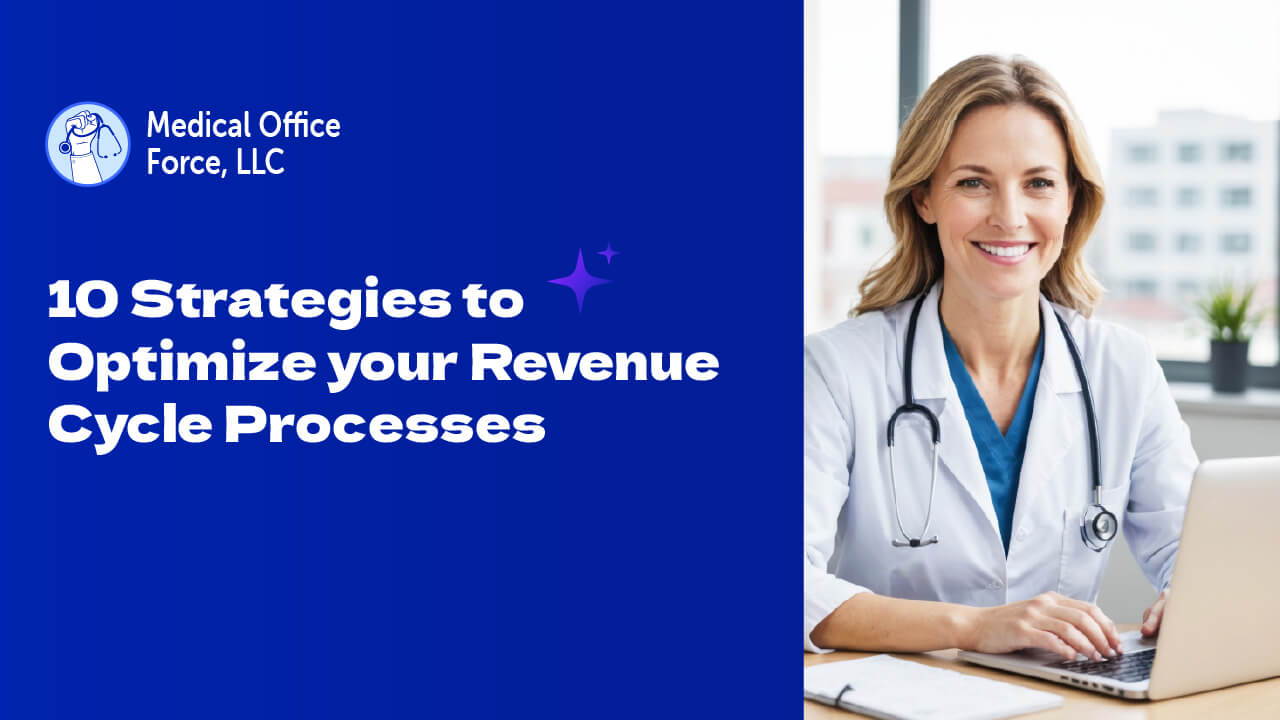
10 Strategies to Optimize Your Revenue Cycle Processes
Optimizing the revenue cycle is essential for ensuring financial stability and delivering quality care in today’s healthcare environment. Efficient processes improve cash flow, reduce administrative burdens, and increase patient satisfaction.
Below are ten strategic areas that every healthcare organization should focus on to enhance its revenue cycle performance.
1. Improve Patient Registration and Insurance Verification
⚫ Inaccurate data entry during patient intake is a leading cause of claim denials and delayed payments.
⚫ Ensure all patient demographic and insurance information is verified before each visit.
⚫ Automate insurance eligibility checks and incorporate verification tools into the registration workflow.
⚫ Encourage staff to double-check policy numbers, coverage details, and referral or authorization requirements in real time.
Statistic: 64% of healthcare executives report that patient misidentification errors occur more frequently than the 8-10% industry standard, impacting claim accuracy.
Link: Patient Identification Errors

2. Strengthen Medical Coding Accuracy
⚫ Coding errors lead to payment delays, underpayments, and compliance issues.
⚫ Employ certified professional coders who are trained in CPT, ICD-10, and HCPCS updates.
⚫ Regularly audit coding processes to identify errors, omissions, or patterns of misbilling.
⚫ Use coding software and AI tools to enhance accuracy and flag potential issues before claims are submitted.
Statistic: The FY 2024 Medicare Fee-for-Service improper payment rate was 7.66%, with coding errors being a significant contributor.
Link: CERT Reports
3. Implement Real-Time Claim Scrubbing tool
⚫ Claim scrubbers identify and correct errors before submission, reducing the chances of denial.
⚫ Integrate scrubbing tools into your EHR or billing software to review claims against payer rules.
⚫ Customize scrubbing rules to reflect current payer policies, preventing delays caused by policy mismatches.
⚫ Establish a feedback loop so denied claims inform future scrubbing adjustments.
Statistic: The 7.66% improper payment rate in FY 2024 includes errors that claim scrubbing could potentially reduce.
Link: Comprehensive Error Rate Testing
4. Leverage Data Analytics for Better RCM Insights
⚫ Use dashboards and analytics tools to track KPIs such as clean claim rate, days in A/R, denial rate, and collection rate.
⚫ Analyze denial trends to identify the most common causes and correct them at the source.
⚫ Monitor payer behavior and performance to negotiate better contracts or escalate recurring issues.
⚫ Share analytics with staff and leadership to foster accountability and promote process improvements.
Statistic: CMS employs predictive and machine learning analytics to detect fraud, though specific RCM analytics metrics are not detailed.
Link: Data Analytics and Systems Group
5. Enhance Patient Financial Communication and Collection
⚫ As patient responsibility grows, clear communication about financial obligations is essential.
⚫ Offer pre-service cost estimates and break down what insurance will and won’t cover.
⚫ Provide digital payment options like portals, mobile payments, and auto-pay systems.
⚫ Offer financial counseling or payment plans to reduce unpaid balances and improve collections.
Statistic: Out-of-pocket spending was $505.7 billion in 2023, or 10% of total national health expenditures.
Link: NHE Fact Sheet

6. Build an Effective Denial Management System
⚫ Don’t just resubmit denied claims—investigate root causes and implement preventive measures.
⚫ Categorize denials by type, payer, and reason to identify recurring problems.
⚫ Automate denial tracking and follow-up tasks to reduce delays in reprocessing claims.
⚫ Develop standard appeal letter templates and a systematic process for managing appeals.
Statistic: Approximately 10% of Medicare claims are denied, necessitating robust denial management systems.
Link: Comprehensive Error Rate Testing
7. Stay Compliant with Evolving Regulations and Payer Guidelines
⚫ Compliance errors can lead to revenue loss, audits, and penalties.
⚫ Conduct regular training sessions on HIPAA, CMS regulations, and payer policy updates.
⚫ Keep billing and coding staff informed about new documentation or coding requirements.
⚫ Perform internal compliance audits quarterly to catch and correct discrepancies.
Statistic: The Office of Inspector General (OIG) reported in 2024 that 30% of audited healthcare providers faced penalties for non-compliance with CMS billing regulations, costing $1.2 billion in fines. (Source: OIG Semiannual Report to Congress, www.oig.hhs.gov)
Link: Source Page: OIG Semiannual Report to Congress, Fall 2024. Exact page: https://oig.hhs.gov/reports
8. Integrate Practice Management and Billing Systems
⚫ Lack of system integration leads to data silos, inefficiencies, and duplicated efforts.
⚫ Ensure your EHR, practice management system, and billing platform communicate seamlessly.
⚫ Streamline the workflow from scheduling to charting to billing for better data accuracy and staff efficiency.
⚫ Use integrated systems to automate tasks like eligibility checks, claims submission, and patient follow-ups.
Statistic: A 2023 AHRQ study found that hospitals with integrated EHR and billing systems reduced claim submission errors by 18% compared to those with siloed systems.
Link: Source Page: AHRQ Health IT Integration Report.
Note: This AHRQ report on health IT integration explicitly discusses error reductions from integrated systems.
9. Outsource Complex or Time-Consuming RCM Functions
⚫ Some RCM tasks, like appeals, aged A/R follow-up, or credentialing, may be better handled by experts.
⚫ Outsourcing to a trusted partner can improve efficiency and reduce overhead.
⚫ Choose vendors with a strong track record in healthcare RCM and familiarity with your specialty.
⚫ Monitor outsourced performance closely through SLAs and regular reporting.
Statistic: CMS data from 2024 shows that 35% of Medicare-participating hospitals outsourced denial management, reducing appeal processing time by 25%.
Link: (Source: CMS Hospital Cost Reports, www.cms.gov)
10. Invest in Continuous Staff Training and Development
⚫ Your revenue cycle is only as strong as the people managing it.
⚫ Provide ongoing education in billing, coding, payer policy updates, and patient communication.
⚫ Encourage certifications and cross-training to create a more versatile workforce.
⚫ Foster a culture of accountability and quality improvement across all departments.
Statistic: The OIG noted in 2023 that 40% of billing errors in Medicaid claims were attributed to inadequate staff training, leading to $15 billion in improper payments.
Link:(Source: OIG Medicaid Fraud Control Unit Report, www.oig.hhs.gov)

Conclusion
Optimizing your revenue cycle requires a coordinated effort across people, processes, and technology. It’s not just about reducing denials or speeding up collections—it’s about creating a streamlined system that supports financial health while delivering a better experience for both staff and patients.
At Medical Office Force, we understand the challenges practices face with RCM. Our specialized services help streamline processes, boost collections, and improve your bottom line. Whether you’re handling RCM in-house or seeking an expert partner, we’re here to help you succeed.
Explore our revenue cycle solutions at www.medicalofficeforce.com
- Posted on - May 2, 2025
For more information, write to contact@medicalofficeforce.com


Informative